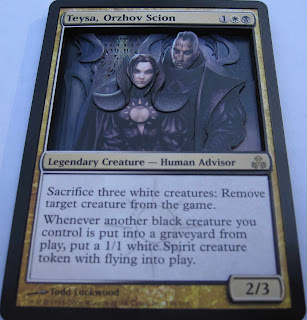I initially built my Teysa, Orzhov Scion deck because white and black were the colors I played the least of among my other decks. I avoided working on this 3D Teysa for a while - it was actually the winner of a poll I put in one of my articles, forcing me to finally make it.
If you're interested in Teysa's story, consider checking out MTG Fiction's review of the Guildpact novel.
Sunday, September 18, 2011
Monday, September 12, 2011
Good Buddy
Anson Maddocks was known for making some of the creepiest, most memorable art of the early years of Magic, but it was the size of this guy that captured my imagination back in those days (10 power! For four manas!!).
Whenever I cut up a Legend I get curious about the character's backstory. Apparently the Lord of Tresserhorn was killed and reanimated by Lim-Dul. Who knew? (beside every Vorthos ever)
Whenever I cut up a Legend I get curious about the character's backstory. Apparently the Lord of Tresserhorn was killed and reanimated by Lim-Dul. Who knew? (beside every Vorthos ever)
Friday, September 9, 2011
If He Rode a Phelddagrif, He'd Be Augustin of Hippo
Grand Arbiter Augustin IV is the epitome of an awkward card for me. The art was fantastic for 3Ding, but the effect is one I'd never play in any deck, ever, let alone as a Commander. For the most part, I try to avoid cards that mess with what other players are trying to do.
That's the reason my Commander decks feature almost no removal - I'd rather spend my cards doing fun things of my own instead of messing with other players' stuff. Sure, not playing Swords to Plowshares and only having counterspells in one deck sometimes causes me to get blown out sometimes, but I want that to happen. I would rather lose a spectacular game than win an average one.
For the walkthrough of how I made this Grand Arbiter, check out the article.
That's the reason my Commander decks feature almost no removal - I'd rather spend my cards doing fun things of my own instead of messing with other players' stuff. Sure, not playing Swords to Plowshares and only having counterspells in one deck sometimes causes me to get blown out sometimes, but I want that to happen. I would rather lose a spectacular game than win an average one.
For the walkthrough of how I made this Grand Arbiter, check out the article.
Tuesday, September 6, 2011
Blinded by the light
After a long wait, I finally finished my first all-foil card, the From the Vaults version of Rith, the Awakener. When it comes to 3Ding, foils present a number of difficulties compared to regular cards. Two big ones are:
1) Foils are much harder to cut, so doing fine details is very difficult.
2) When you cut open a foil, you expose not only the inner white (which normally is easy to color away with a pen) but also the plain foil layer (which can't be colored away with a pen). This makes edging tricky; some spots will have shiny dots or lines because of the foil peeking out.
While working on Rith, I discovered another issue. The "memory" of foil cards (their tendency to revert back to their original shape) means that shaping & molding of parts of the card doesn't work as well as with normal cards. I tried to mold the top layer of trees to ripple and bend in multiple directions to give it more depth, but each time it would return to mostly-flat after a couple hours.
Despite the challenges, Rith turned out really well!
1) Foils are much harder to cut, so doing fine details is very difficult.
2) When you cut open a foil, you expose not only the inner white (which normally is easy to color away with a pen) but also the plain foil layer (which can't be colored away with a pen). This makes edging tricky; some spots will have shiny dots or lines because of the foil peeking out.
While working on Rith, I discovered another issue. The "memory" of foil cards (their tendency to revert back to their original shape) means that shaping & molding of parts of the card doesn't work as well as with normal cards. I tried to mold the top layer of trees to ripple and bend in multiple directions to give it more depth, but each time it would return to mostly-flat after a couple hours.
Despite the challenges, Rith turned out really well!
Subscribe to:
Posts (Atom)








